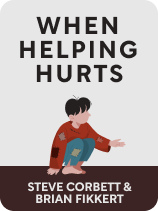

This article is an excerpt from the Shortform book guide to "When Helping Hurts" by Steve Corbett and Brian Fikkert. Shortform has the world's best summaries and analyses of books you should be reading.
Like this article? Sign up for a free trial here.
What is microfinance? What are a few microfinance models?
Microfinance is a particularly effective tool for catalyzing long-term development and helping poor people in developing countries improve their lives and businesses. There are three microfinance models that churches can get involved in to help those in poverty.
Let’s look at what microfinance is and the three models that churches can use.
What Is Microfinance?
Microfinance (MF) consists of very small loans (anywhere from a few cents to a few hundred dollars) made to people who wouldn’t qualify for credit at traditional banks. As the authors explain, the MF movement originated in 1976, when an economics professor established Grameen Bank in Bangladesh to provide credit to poor people. His motivation for establishing the bank was to create an option for poor people to borrow money without having to turn to predatory lenders or meet the high loan amount requirements of larger financial institutions. Steve Corbett and Brian Fikkert in When Helping Hurts say that as of 2014, the Grameen Bank has lent over $7.4 billion and has nearly 8 million borrowers. In addition, almost 100% of the loans have been paid back in full.
Because of Grameen Bank’s success, organizations have established many microfinance institutions (MFIs) to help poor communities across the world. This means that North American churches have many opportunities to team up with churches and ministries in impoverished communities to provide support on a global scale. Corbett and Fikkert mention a number of microfinance models for church involvement, which we’ll discuss in turn.
1. Provider Model
Corbett and Fikkert explain that the provider model consists of a church in a developing country establishing and running an MFI on its own. They caution that this model is rarely successful. One reason for this is that sustaining an MFI requires a large amount of technical, managerial, and financial resources, which churches and other local ministries rarely have.
In addition, because churches are built on values like grace and empathy, they often struggle to enforce loan repayment—especially when the borrower is in a dire situation. For example, it’s hard to penalize a sick, elderly woman who’s struggling to repay a loan.
2. Promotion Model
With the promotion model, Corbett and Fikkert continue, churches establish a Savings and Credit Association (SCA), where members save and lend each other money from their collected savings. In contrast to a traditional MFI, which primarily uses donor money to fund loans, SCAs function solely on the money of their members.
In an SCA, each member agrees to contribute a fixed sum every week. They also participate in a weekly meeting, where they collectively decide how much money to lend and to whom they should lend it. At the end of a fixed period (usually six to 12 months), members receive all of the money they’ve contributed, plus the interest that borrowers paid on their money when it was loaned out.
(Shortform note: In some SCAs, the members agree up front to loan out the association’s money to each member in turn for a specified period of time on a fixed rotation, rather than meeting weekly to decide how much to loan to whom. This is called a “rotating SCA” or ROSCA. Some sources describe ROSCAs as more equitable than traditional SCAs because they’re less susceptible to racial or other bias on the part of the members who decide who to lend money to in a traditional SCA.)
Corbett and Fikkert argue that this model has a variety of benefits. First, SCAs can fulfill a need that traditional MFIs can’t because traditional MFIs are often unable to make loans smaller than $40 or $50 due to the administrative costs of making a loan. SCAs can also administer loans for any purpose (like funerals or medical bills), whereas most MFIs only make business loans.
(Shortform note: Some sources report that SCAs are particularly useful for helping members improve their housing situation because they don’t require collateral like home loans do, and, as Corbett and Fikkert point out, they can make loans for any reason, including housing needs.)
Although churches can establish SCAs, SCAs are run by the members themselves. This not only takes the burden of lending and collecting money off the churches but also empowers the poor to manage their own money. And the founding church can more easily integrate biblical teachings into the SCA’s weekly meetings than it can into traditional MFIs.
However, Corbett and Fikkert also acknowledge that there are some disadvantages. In particular, poor people sometimes struggle to manage the SCA, including keeping records and enforcing loan repayment. It’s also harder for SCAs to mobilize larger sums of money because their money supply is limited to what the members themselves can contribute.
3. Partnership Model
According to Corbett and Fikkert, the partnership model consists of a collaboration between MFIs and churches: The MFI is responsible for offering financial services, while the church supports the poor through services like counseling, training, emergency assistance, and evangelism. By working together, you can address poverty at both the individual and systemic levels.
The advantage of this type of partnership is that it eliminates the problems of the provider model. In particular, it removes responsibility from the churches to provide technical, managerial, and financial resources, because the existing MFI does that on its own. It also provides an opportunity for churches to integrate evangelism into the MFI, which is usually absent without their involvement.
However, Corbett and Fikkert acknowledge that although this is an effective model in theory, it’s not always easy to carry out in practice. This is because both MFIs and churches sometimes lack a holistic vision—churches sometimes have difficulty expanding their focus beyond people’s spiritual needs, and MFIs tend to function on the belief that money alone can alleviate poverty. If the church and the MFI have difficulty reconciling their perspectives, they may have difficulty working together.
Managing a Partnership
If your church is considering using the partnership model, some of the principles used in forming and managing business partnerships can provide relevant insight, even though your church isn’t a for-profit business, and the MFI may or may not be.
For example, in his book Crossing the Chasm, business consultant Geoffrey Moore observes that when two businesses—especially two businesses with relatively different cultures and values—try to coordinate their operations extensively through formal processes, the result is usually detrimental to both companies instead of beneficial. He advises keeping partnerships simple, mutually beneficial, and relatively informal: You produce one product or service, your partner produces a different product or service, and you each make sure your customers are aware of your partner’s products because the products are complementary.
Similarly, business and marketing consultant Regis McKenna asserts that the two keys to a successful partnership are adequate communication and adequate separation: Both partners need a clear understanding of who is responsible for doing what. And both partners need to retain their autonomy so that they can be responsible for their respective parts.
From this standpoint, a partnership between a church and an MFI such as Corbett and Fikkert suggest seems viable, because the respective services that they typically provide can be complementary but have very little overlap.
Criticism of Microfinance
Some sources argue that microfinance institutions are not as effective at helping the poor as Corbett and Fikkert suggest. In Poor Economics, Abhijit Banerjee and Esther Duflo discuss several factors that limit the usefulness of microfinance loans.
For one thing, they note that microfinance companies typically prefer to make a loan to a group of people rather than to an individual. This reduces administrative costs (because there are fewer loans to track). Moreover, it reduces the risk of non-payment because other people in the group must make up the difference if one person fails to repay his share of the loan. However, this shifts liability for the loan to the recipients, rather than the lender, which makes loans less attractive to poor people.
Both Corbett and Fikkert and Banerjee and Duflo note that microfinance companies were created to provide poor people with a more helpful alternative to predatory lending services (lenders that charge exorbitant interest rates to cover the risk of loaning money to people with no credit). But some sources report that in recent years the distinction between predatory lenders and microfinance institutions has become blurred, leading poor people to borrow money at high-interest rates and become trapped in debt.

———End of Preview———
Like what you just read? Read the rest of the world's best book summary and analysis of Steve Corbett and Brian Fikkert's "When Helping Hurts" at Shortform.
Here's what you'll find in our full When Helping Hurts summary:
- How many Christian church missions actually do more harm than good
- A look into the true nature and causes of poverty
- Suggestions for how to help the poor more effectively






